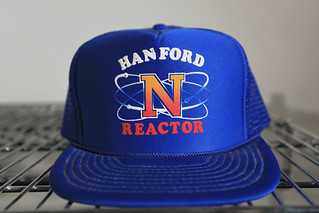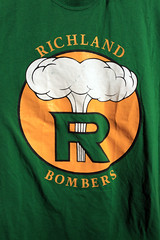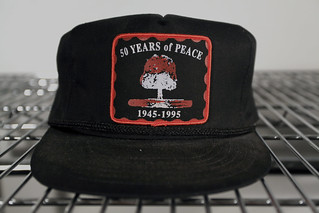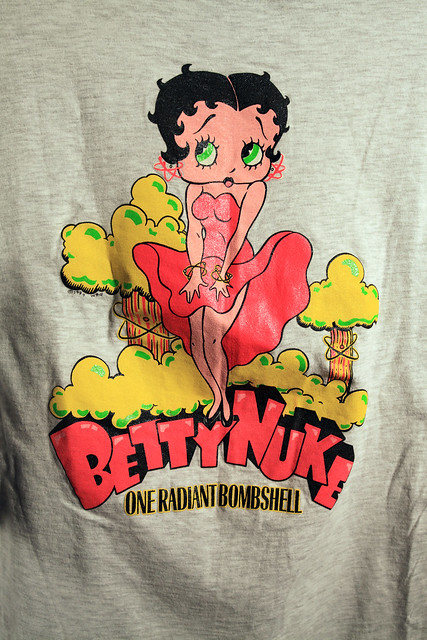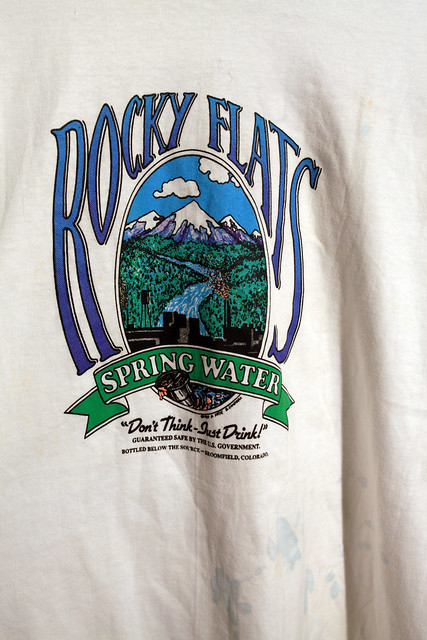The National TLC Service received its inaugural donation of materials for our digital archive of nuclear humor from a former Department of Energy inspector who collected clothing items over many years of visiting nuclear weapons sites. These shirts and caps represent a range of popular responses to the nuclear weapons and energy complexes and include items created for atomic tourists and nuclear workers alike.
Many of these items appear to earnestly celebrate the “home team” of the larger nuclear enterprise and adopt the atomic bomb as an icon for potency and strength. Richland, Washington is home to the Hanford Site, a mostly decommissioned nuclear production facility that for decades manufactured plutonium for atomic weapons. Considered a feat of engineering genius and the centerpiece of the Manhattan Project, the B reactor at Hanford was built in secrecy in only 13 months by over 50,000 workers, who did not know what they were building. Commissioned to produce plutonium-239 by nuclear fission for the US nuclear weapons development program during WWII, B Reactor was the world’s first full-scale nuclear reactor. After more than 20 years of plutonium production, including that used in the first atomic test–Trinity–at Alamogordo, NM and in the “Fat Man” bomb dropped on Nagasaki in 1945, B Reactor was shut down in 1968 and was scheduled to be cocooned for seventy-five years, to allow for on-site radioactivity to decay.
The remaining enrichment facilities for the atomic weapons complex were decommissioned by the late 1980s, though the Pacific Northwest National Laboratories, the Hanford Observatory, and a commercial nuclear power plant continue to operate on the site. The most contaminated nuclear site in the United States, Hanford is the focus of a major, ongoing clean-up effort and is now open to tourism–in part to reassure the public that the site is ‘safe enough.’ The city of Richland would scarcely exist without Hanford and, despite the indelible (and largely invisible) marks left by radioactive waste the city still identifies strongly with its nuclear heritage. Richland High School’s mascot–The Bombers–was never decommissioned, and the high school sports teams continue to use the mushroom cloud logo (adopted in 1972), despite intermittent controversy.
Other artifacts of more general provenance appear accept the Cold War doctrine of deterrence.
Some domesticate, feminize, and sexualize nuclear detonations in a manner familiar from the Miss Atomic Bomb pageant or, indeed, the nuclear namesake of the bikini swimsuit itself.
Nevertheless, it is important to remember that people purchase these items for varied reasons, with ironic consumption potentially a larger share of the market than the manufacturers planned.
Some items are intended less for mass marketing and tailored instead to a small subset of nuclear workers. These often reveal a much more cynical strain of humor. This hat, for example, seems to be a play on the popular 1980s children’s TV show, “Pound Puppies.”
The hat circulated among disillusioned workers at the Rocky Flats plutonium trigger production plant outside of Denver, CO when it was revealed that management had dealt with radioactive waste by dumping it into an on-site pond. The “solution” was to dredge the contaminated mud, mix it in concrete, and place the resulting “pondcrete” in cardboard boxes on outdoor shelves, exposed to the elements. Rocky Flats was raided by the FBI for environmental crimes in 1989 in an operation called “Operation Desert Glow.” The production of weapons components ended at Rocky Flats in 1992.
This shirt, also from Rocky Flats around the same time period, draws its iconography from bottled water labels. Below the expected pristine mountain stream, however, the shirt depicts an industrially polluted waterway, with ominous barrels of waste leaking beyond the confines of the image’s frame. The shirt came “pre-stained” with splash marks, purportedly from the radioactive water. The bitter tagline: “Don’t Think, Just Drink! Guaranteed safe by the US Government. Bottled below the source, Broomfield, Colorado.” An expedited clean-up was declared complete in 2005, and the Rocky Flats National Wildlife Refuge was established in 2007.
About the Archive
When the National TLC Service was established in May 2011, we were tasked with developing collaborative cultural projects to help build a more robust public dialogue about the Cold War. After extensive internal study, we concluded that, at initial levels of staffing (2) and funding ($0), the most feasible project proposed in our establishing documents would be the Digital Archive of Nuclear Humor, dedicated to “chronicling the inventive ways that 20th and 21st century people laughed in the face of mutation.” The National TLC Service recognizes that the ironic mode, mobilized into satire, has long been the most popularly accessible form of nuclear critique, practiced to legendary effect in the classic film, Dr. Strangelove, or: How I Learned to Stop Worrying and Love the Bomb While we are cautious about the potentially politically disabling effects of irony (such as practiced by white hipster culture), we hypothesize that ironic consumption of Cold War monuments and icons may be most individuals’ first and most intimate expressions of nuclear unease. The National TLC Service has initiated this digital archive of nuclear humor to consider how the affects and aesthetics of irony, satire, and camp might be activated to permit the contemplation of the unimaginable and forge the new, trans-natural identifications and solidarities demanded by a world characterized by widespread exposure and shared but unequal risk.

